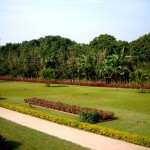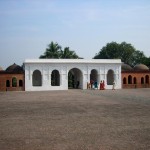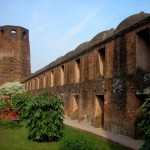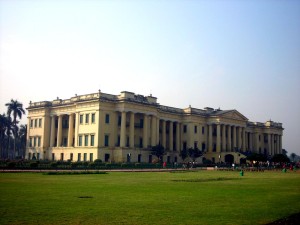The handmade artifacts of Bishnupur in Bankura are quite famous all over the world. Terracotta is the raw material with which the highly skilled craftsmen of Bishnupur create various artifacts which are magnificent in design and flawless in their shape.
Terracotta Potteries
Terracotta potteries and artifacts are Bengal’s wealth and have a long and glorious history. The theme of the artifact is usually a folk one and quite explicit in its execution. The clay used to make all the handcrafted items is gathered from the river beds, ditches and pits. Usually 2-3 types of clays are mixed to form an alloy to make the world class artifacts appreciated by people. The craftsmen still use the traditional form of kilns to bake the clay pots using firewood, dry leaves and twigs. The pots are baked at a temperature of 700-800 degree Celsius. Not only men but the women also help in creating these beautiful objects. The women potters generally work on the wheels to give the pots their round neck on the upper halves. These round necks are perfect in shape. The potters also make clay dolls and other toys for children. Most of these toys and dolls are cast in burnt clay moulds which are typical of Bishnupur. Not only toys and pots, they also make animal figures, wind chimes and jewelry items from burnt clay or terracotta which is quite famous. The terracotta horse structures are treasured by tourists.
Dokra Metal Casting
Dokra metal casting is another interesting form of craft practiced by the tribes of Bishnupur who are known as the Dokra Damar. This eponymous crafting technique is basically done with wax and the items created have a lovely hue and texture. The process of Dokra casting is also referred to as ‘cire perdue’ technique or lost wax casting process. Dokra items have clay as their core material over which wax is coated. After the wax coating, a clay paste coating is applied on the model and dried for some time. The traditional hollow casting method is followed by which wax is replaced by another molten metal; in this case it is usually brass. A number of objects are made from dokra which include cutlery, jewelry items, lamp, chains, religious symbols, bells and many more. People who love tribal designs buy dokra objects to beautify their homes. Dokra jewelries are also popular among women. The art of okra is a surviving legacy of the region.
Handcrafted Silverware
Handcrafted silverware is also hallmark of Bishnupur, Bankura tradition of handicrafts. The art of making silver items is quite old in the region with many skilled craftsmen practicing it. Silver enameling is done on various figures of home décor to enhance the appearance and add to their charm. Filigree designs on silverware can be found in abundance in the region. The objects comprising of these designs look outstanding and delicate. Then there are items made from silver. Various figures, jewelry items, utensils are made from silver which are embellished with beautiful designs making them appear unparallel in their beauty. These can be the perfect gifts for special occasions.
Tussar Silk
Tussar Silk is produced from silkworms. It is also known as Tusser, Tushar and Tussah and the sarees made from this particular silk is very popular in India. Its popularity is due to the gold sheen and has shorter fibres. It is the chosen material for saris and also punjabis for Indian men. The gold sheen makes it appear rich textured and also shimmering. Bulk production is Tussar silk is done in India out of which around 40% is from West Bengal. The tussar silk sarees produced in Bankura are famous for their kantha stitch which is a particular type of stitching process done by hand instead of machines. Kantha stitched silk sarees are quite expensive and exquisite. Tussar silk sarees are available in various beautiful colors. Tussar silk is also used to make punjabis for men and salwar suits for ladies. These traditional apparels also appear beautiful made from this silk. Producing Tussar silk is considered to be a cottage industry in Bankura where a large number of handlooms are found. This is a tradition of Bankura and thus the weavers still maintain the conventional handloom process to produce the silk sarees. Tussar Silk is also known by another name which is Kosa Silk. Tussar Silk clothes are exported to Gulf countries, to the USA and also various European countries. Know More →



